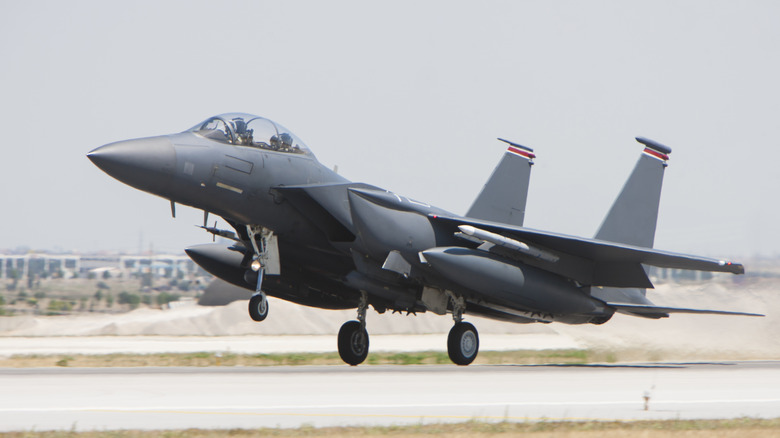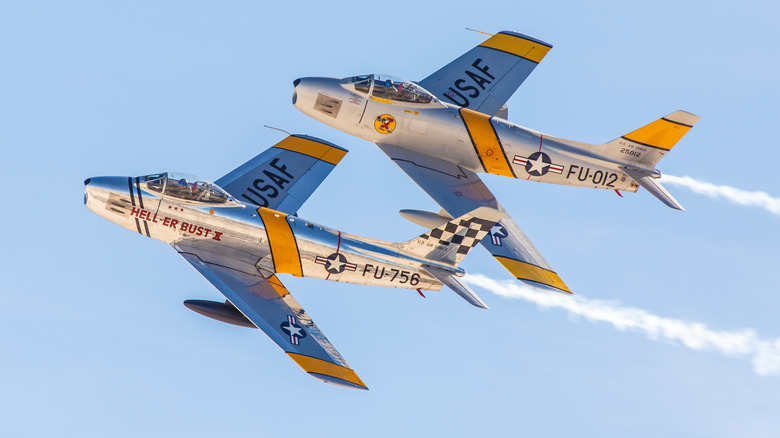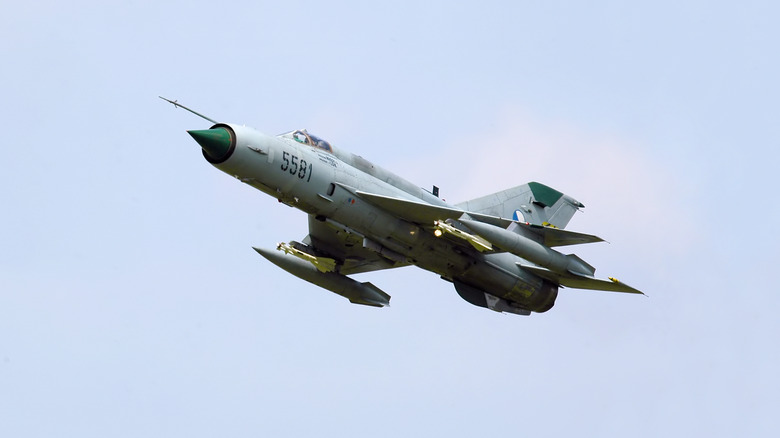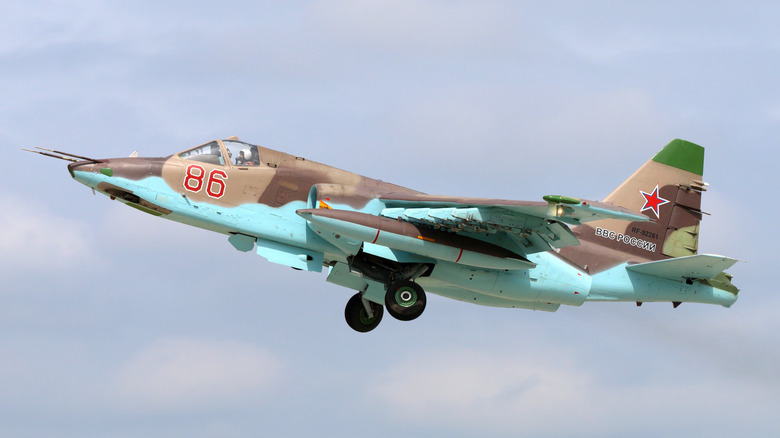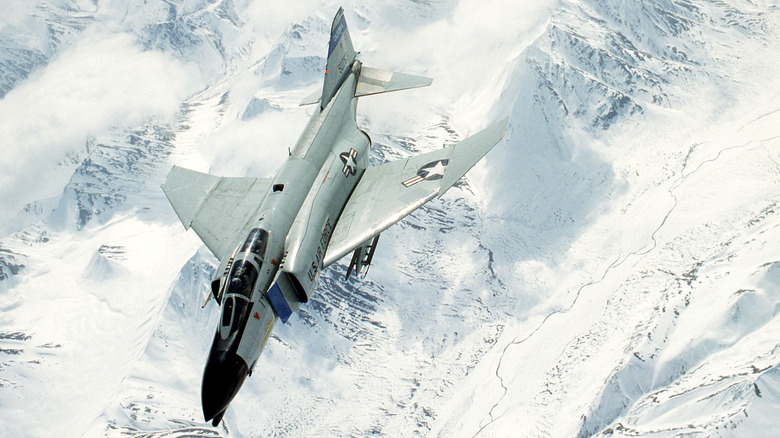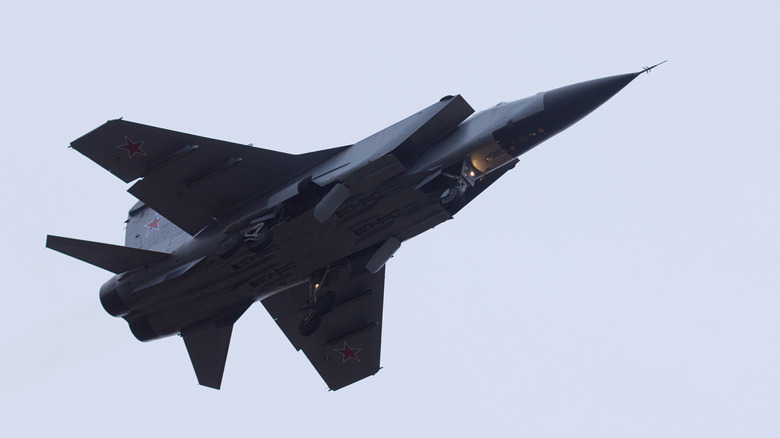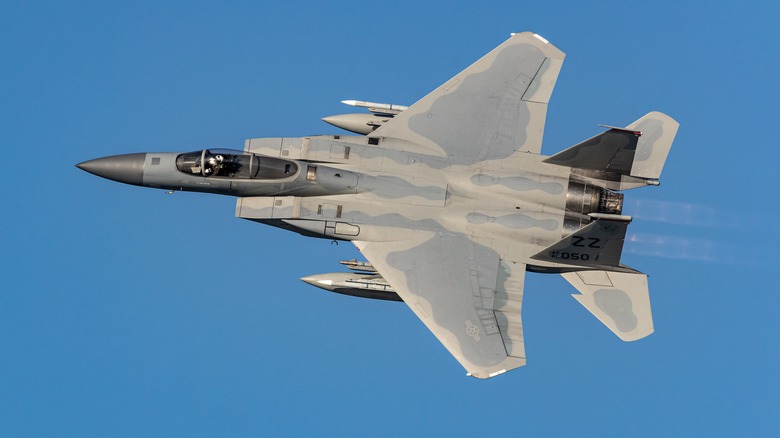6 Best Fighter Jets Developed During The Cold War
From the late '40s to the early '90s, the Soviet Union and the United States militaries were locked in a rivalry for technological superiority. With the threat of nuclear weapons from both sides paired with the understanding that it didn't matter who shot first, both countries engaged in an elaborate Cold War in an effort to prove which side could do just about anything better. With that as the backdrop, it's easy to see why the race for the best fighter jet in the world would become one of the many "races" the two superpowers engaged in.
Regardless of the reason, the Cold War era produced some of the most legendary fighter jets in history. As each superpower would make breakthroughs in new technologies, the other would quickly try to catch up, and every few years, we would inevitably see new jets, new methods of mass destruction, and new technology that would shape our militaries for decades to come. Without further ado, these are the fighter jets the other side feared the most.
F-86 Sabre
The F-86 Sabre was the first U.S. fighter jet to employ the swept-wing design pilfered from German engineering just after World War II. While this is an older plane, the impact it had makes it one of the best fighter jets born of the Cold War. It had a top speed of 685 mph, which was a world record at the time in 1948. More than 5,500 of the fighters were built and used by more than 20 other nations.
The F-86 Sabre saw major combat during the Korean War and accomplished air superiority throughout the conflict. What's especially amazing is that American pilots were up against Soviet MiG-15s, an accomplished fighter in its own right. But by the end of the Korean campaign, the Sabre had shot down 792 MiG-15s, while the Soviets had only shot down about 100 Sabres. That's an 8:1 ratio and a success rate that puts the Sabre on the list as one of the best fighter jets of the Cold War.
MiG-21 Fishbed
The MiG 21 was easy to produce, extremely maneuverable, and gave most fighter jets of its era a run for their money. Its production began in 1959, and to this day, it is the most-produced fighter jet of all time, with 10,645 units. It's important to note that the Americans gave it the codename "Fishbed," and the Soviets hated it, but that was likely the point.
The MiG-21 had triangular delta wings (instead of the swept-wing designs popular at the time), which meant it had more surface area on the bottom of the wings to carry weaponry. It had a twin-barrel 23mm cannon for up close and personal dogfights, but it could also carry nearly 4,500 pounds of a variety of air-to-air missiles and rockets.
During the Vietnam War, it was highly successful against American F4s and F-105s because it was much more agile than its American counterparts, even if it moved at slower speeds. Even though the MiG-21 is outclassed by the newer MiG-23, MiG-29, and MiG-31, variations of the MiG-21 are still flying to this day in several parts of the world.
Sukhoi SU-25
Though the A-10 gets the nickname "Flying Tank," the Soviet Sukhoi SU-25 is a comparable fighter jet. It is mostly a ground-attack fighter, but it has air-to-air armaments as well. It has a 42,000-pound max take-off weight, meaning it can carry a multitude of missiles and bombs. Its air-to-air capabilities occupy the outer portion of each wing, but the rest is all for ground attacks. The SU-25 also had upgraded NAV systems in later versions and a laser range finger in the nose.
The SU-25 did most of the heavy lifting during Russia's war with Afghanistan. Lessons learned from the Vietnam War urged Russia to shift to a slower but more agile and heavily armored fighter jet. The SU-25 fit the bill but offered better pilot protection than other jets, with titanium surrounding the cockpit and bulletproof glass, both of which can withstand 12.7mm rounds. It has seen action in roughly 40 different conflicts. The SU-25 has had several revisions over the years, adding armor and more advanced technologies, and is still flown in many countries today.
McDonnell Douglas F-4 Phantom II
The F-4 Phantom II was a famous fighter jet that could top two times the speed of sound. It entered service in 1961 and was quickly recognized as being an extremely versatile fighter that could handle both air-to-air and air-to-ground combat. It saw combat in both the Vietnam War and, much later, in Desert Storm. Even flight teams like the Blue Angels and the Thunderbirds utilized this versatile fighter's capabilities in air shows.
The Phantom was fast but also loaded with weaponry for any situation. It had four AIM-7E and four AIM-9B air-to-air missiles for dog fights, and it also carried eight Mk 117 bombs at 750 pounds a piece. In fact, it could carry up to 16,000 pounds of externally carried ordinance.
What's crazy about the F-4 Phantom is even just as a prototype in 1959, it broke 16 records for maneuverability, including overall speed and speed while climbing, and also shattered the altitude record at the time, rising to over 98,000 feet. Though it's out of production today, it was used as recently as 2014 as a remote target for new pilots over the Gulf of Mexico.
MiG-31 Foxhound
The MiG-31 Foxhound was introduced in 1982 and has the designation as one of the fastest fighter jets in the world. It sports Zazlon M radar systems, which allow the pilot to automatically track 24 target aircraft and engage as many as eight simultaneously. It comes equipped with a variety of different missile systems depending on the specific mission but features four Vympel R-33 long-range air-to-air missiles with a range of 75 miles.
One drawback to this heavy fighter is that it isn't very agile. It can get you where you need to go quickly in a straight line, but it isn't nearly as useful in dogfights. Instead, the MiG-31 was recently especially useful over Ukraine because of its high-tech, long-range air-to-air missiles that could take out Ukrainian fighters that didn't have the same speed or firepower as the MiG-31.
The Russian defense ministry has just 315 of the aircraft today. It is still in deployment, and Russia says it will at least be around until 2030.
F-15 Eagle
The F-15 Eagle is considered one of the best fighter aircraft in history. This fighter offers both blazingly fast speed and agile maneuverability. It can do over two and half times the speed of sound, slow down into a dogfight, and outmaneuver nearly any enemy. It has recorded 104 aerial victories and zero losses in dogfights. Amazingly, it was introduced in the 1970s and has gone through several upgrades over the years to keep it up with newer fighters currently in deployment.
What sets the F-15 apart from other fighter jets is the amount of technologies used to make it an ultimate killing machine. Advanced avionics, radar and weapon systems, and more are all speaking to each other on onboard computers, and then the pilot's heads-up display projects all the information on the windscreen so the pilot can see everything at a glance.
When the pilot switches to a different weapon system, the heads-up display automatically switches to information about that system. Furthermore, its electronic warfare system can display and track threats and offers a countermeasure system that will deploy automatically when it detects incoming missiles.
The F-15 Eagle is a marvel among fighter jets for its technology and versatility. As one of today's most successful aircraft, you can bet it will be around for years to come.
